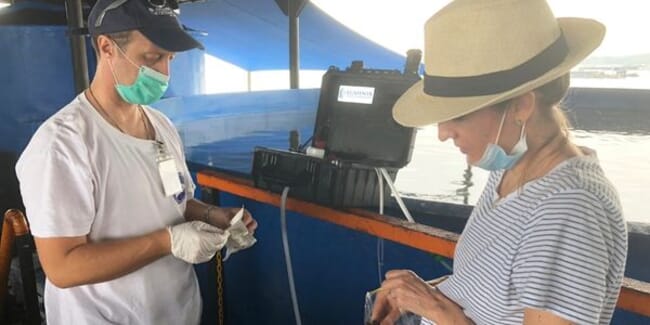The trouble with water treatment in aquaculture
Published on by Water Network Research, Official research team of The Water Network in Case Studies
Water disinfection is a necessary step in preparing aquaculture facilities before stocking, but it also causes microbiome die-offs which result in the higher likelihood of disease further down the line, according to Rachelle Jensen, founder of Luminis Water Technologies.
To provide fundamental insights into water health, Jensen has created AquaGENius, a microbiome field testing kit which allows farmers to quickly and easily take a sample and send it to the Luminis lab for next gen sequencing and in-depth analysis.
Can you explain the company’s technology and why it’s needed?
In the drive to lower the pathogen load by water disinfection almost all of the critically important beneficial microbes are wiped out as well, a recent study shows. We have also found that many probiotic treatments are not optimised correctly, which results in a loss of both water health and profit.
By using AquaGENius, farmers can gain “health snapshots” at the species-level of all beneficial bacteria, determine if probiotics are seeding properly, spot problems with imbalances or biodiversity, dive into Cyanobacteria, algae and parasites, including pathogen and viral loads.
We provide microbiome analytics and insights with next gen sequencing (NSG). On a practical level, we determine our client’s objective, then we put together a sampling design that will match both the goal and the budget. The sampling kits are sent out, and we proceed with sequencing and analysis.
 Hybrid groupers swimming in culture water
Hybrid groupers swimming in culture water
Microbiome analytics can deliver significant benefits for pond operations that rely on probiotics and water treatment protocols. © Luminis Water Technologies
How can these be applied to the aquaculture industry and to what parts of the industry are they most suited?
Microbiome analytics are particularly well suited for RAS or closed systems where water is prone to pathogen build-up and water quality issues. But we can also deliver significant benefits for pond operations that use probiotics and water treatment protocols.
We think of microbiome analytics as a form of X-ray vision for water. We can "see" exactly what’s happening at the species level. This is a really important distinction because with this level of visibility we can deliver huge cost savings for our clients.
We’ve found that 9 times out of 10 probiotics are not working, which means the operator is simply throwing money down the drain. Some of the mistakes we see are using blends that have the wrong profile of bacteria, using low quality products, or using probiotics that don’t address the specific issue present in the water at the time of seeding.
With our services, operations can ensure their water is balanced and ready for the rigours of farming, and they can achieve significant savings by optimising their probiotics.
Rachelle Jensen, founder of Luminis Water Technologies
Share this
In terms of water disinfection, the same techniques used to reduce the bacterial pathogen load are also very good at eliminating beneficial bacteria and biodiversity. Once this important element is lost, the microbiome enters a state of dysbiosis which creates the perfect condition for a pathogen outbreaks. We can provide a detailed analysis on how much risk was introduced during the disinfection process, and recommend steps farmers can take to mitigate these risks.
With our services, operations can ensure their water is balanced and ready for the rigours of farming, and they can achieve significant savings by optimising their probiotics.
How do they differ from other methods used in the industry to assess microbiomes?
At this time, we’re the only company offering next gen sequencing to gain insights into the microbiome. Other companies use flow cytometry which is a great tool, and very cost-effective, but the visibility is limited, especially as it pertains to gaining insights into the bacterial segment of the microbiome, which is the most important driver of health in both water and stock.
 Rachelle Jensen (R) testing water from a RAS
Rachelle Jensen (R) testing water from a RAS
Microbiome analytics are particularly well suited for RAS or closed systems where water is prone to pathogen build-up and water quality issues. © Luminis Water Technologies
Attached link
https://thefishsite.com/articles/the-trouble-with-water-treatment-in-aquaculture-luminis-water-technologiesTaxonomy
- Aquaculture